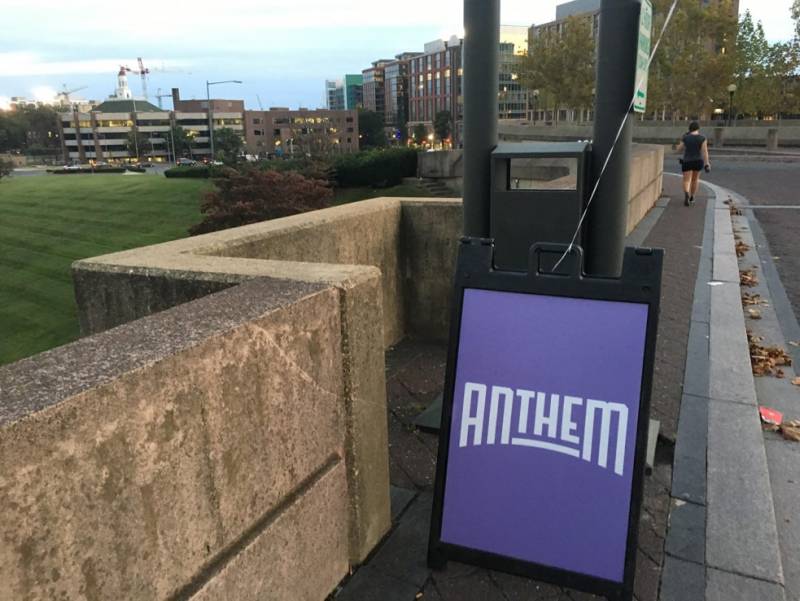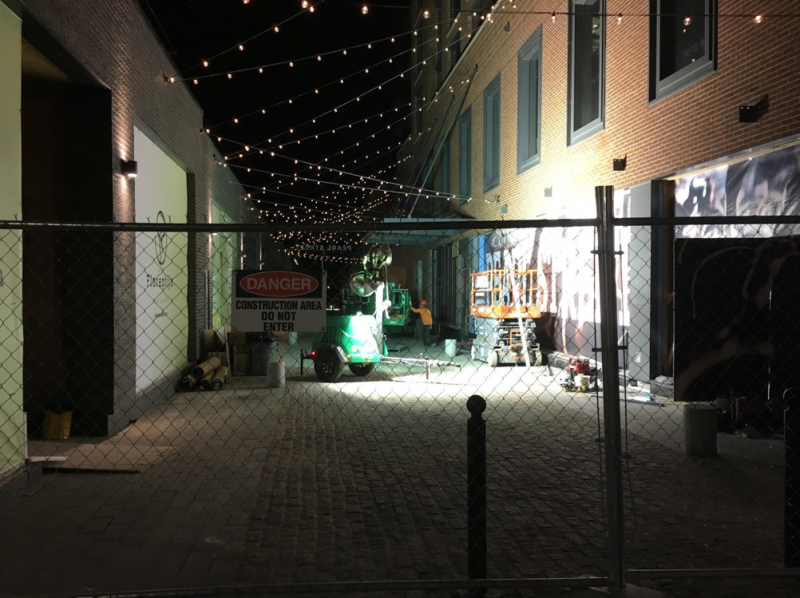First impressions of the Wharf: Mega-projects have pros and cons

View from a balcony at The Anthem.
Cities shouldn’t build neighborhoods to a finished state, say urbanist advocates at Strong Towns. Here at GGWash, we’ve similarly pointed out the problems with the “instant neighborhood” phenomenon in the region.
The Wharf, a giant new development on the Southwest Waterfront set to publicly open October 12 is perhaps the clearest example of a “finished” neighborhood in DC to date. Its success or failure will be watched closely for lessons in urban development.
Over the weekend, I had the chance to attend the soft opening of the Anthem, a new music venue at the Wharf from the owners of local venues like the 9:30 Club and Lincoln Theatre. Here are some preliminary thoughts on the Wharf from an urbanist perspective: One of the main plazas in The Wharf. Image by the author.

The $2 billion, 24-acre development will bring together multiple trends in DC real estate: waterfront redevelopment, luxury residences, and hip shopping and entertainment options aimed at suburb-spurning Millennials.
In stark contrast to the Euclidean zoning that has dominated modern American planning, the Wharf promises to let you work, live, and play all in the same place, commingling offices, retail, apartments, nightlife, and restaurants.
In other words, the Wharf is going all in on the notion that people today, especially the young and upwardly mobile, want everything mixed together – and they’re willing to give up staples of previous generations like large residences and copious parking to get it. New apartment buildings aren’t just close to the action – one of them, The Channel, literally wraps around the Anthem.
While living next to the soon-to-be-host of Foo Fighters, LCD Soundsystem, Lorde, and others is surely part of the appeal, recent history has produced no shortage of seemingly incoherent opposition.
Standing on the outdoor balcony area, I overheard multiple conversations wondering if residents of The Channel would really be OK with the crowds and noise on weeknights, especially in a relatively buttoned-down town like DC. It’s all well and good until Dave Grohl is keeping the kids up.
(For what it’s worth, the Anthem’s owners are confident in their sound-proofing. But that doesn’t account for the noise of drunken revelers after the shows let out.)
On the way from L’Enfant Plaza to The Wharf. Image by the author.
The Wharf is opening in several phases, allowing for a sort of prolonged soft opening to test the effects on local transportation and infrastructure. Thankfully for smart growth adherents, the Wharf is walking distance from two Metro station, L’Enfant Plaza and SW Waterfront. (The Anthem’s instructions for opening night advised using L’Enfant.)
Once I arrived at L’Enfant Plaza via Metro and successfully found the right exit–the Anthem’s emailed directions were less than helpful, and in-station signage nonexistent–the walk from L’Enfant to the Wharf was quite pleasant, with bright purple signs pointing the way.
However, it would be more difficult in extreme heat or cold or if I had mobility issues, and the crowds for larger events may strain the narrow sidewalks currently found between L’Enfant and Maine Avenue. Plans for redeveloping the area to improve bike/ped options would be a welcome change.
As for leaving the area after the show, my experience was encouraging. The show I went to wrapped up around 10 PM–by design, the Anthem’s start times will be earlier than sister venues like the 9:30 Club–and the crowd dispersed fairly smoothly. Bikeshare stations were busy, a steady stream of people headed for both nearby Metro stations, and Ubers and Lyfts were hailed without issue.
We’ll see what happens on Thursday, when 6,000 fans are expected for the sold-out Foo Fighters show. Metro’s reduced late-night hours may pose problems when shows end later, especially on weeknights.
View of Pearl Street SW. Image by the author.
Overall, my experience of the Wharf–albeit a limited glimpse–was cause for optimism mixed with some trepidation. A major investment in a walkable, transit-accessible area featuring many local entrepreneurs sounds great on paper, and the shiny modernity of the buildings combined with the fixed-up riverfront will surely draw flocks of visitors and gobs of revenue to DC.
It was certainly pleasant to be able to stroll around several dense blocks without fear of car traffic, reminiscent of great nightlife spots like Bourbon Street in New Orleans or 6th Street in Austin (though of course without their well-earned historic character). I know I’ll be seeing more shows at the Anthem, and as a car-free urbanite I’m happy to see major acts coming to the city rather than car-oriented venues like Wolf Trap or Merriweather Post Pavilion.
The problem is that the Wharf is largely self-contained, dampening the spontaneous interactions that make urban areas great to begin with. And, being constructed all at once, it’s unlikely to develop the unique character of an Adams Morgan or Capitol Hill, where you can stumble into a great shop or restaurant in an alley or English basement.
Overall, the Wharf’s all-at-once style exemplifies what Richard Florida calls “The New Urban Crisis”: (re)development that primarily serves the affluent, without doing much for large swaths of the rest of the city, much of which is still starved for investment. This can produce enclaves of opulence disconnected from long-standing neighborhoods.
For better or worse, that seems to be the direction DC is headed, as smaller-scale development in “stable” neighborhoods has become exceedingly difficult. As vacant industrial space in the city dwindles, it won’t be sufficient to put all of our eggs in the mega-development basket.
